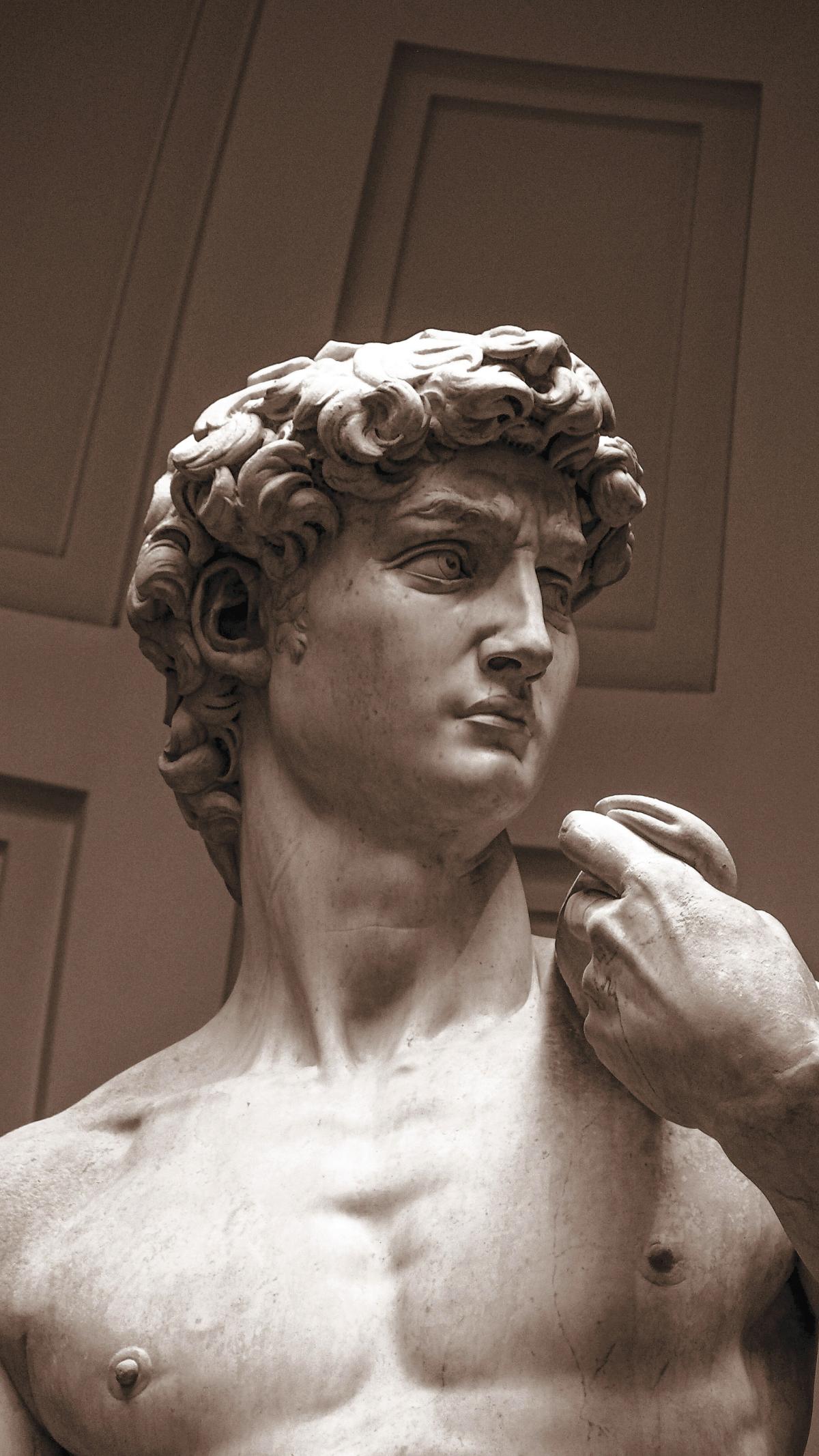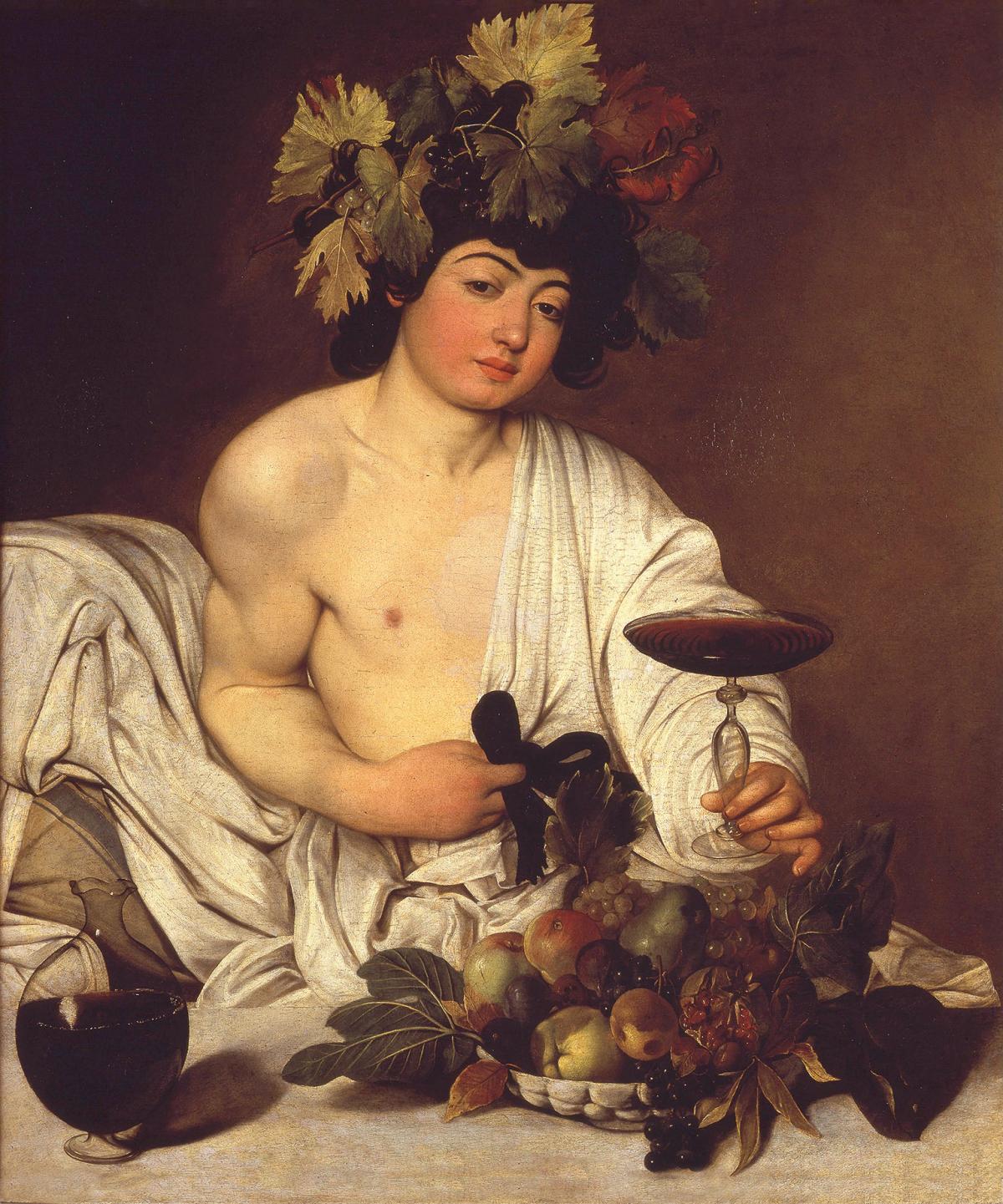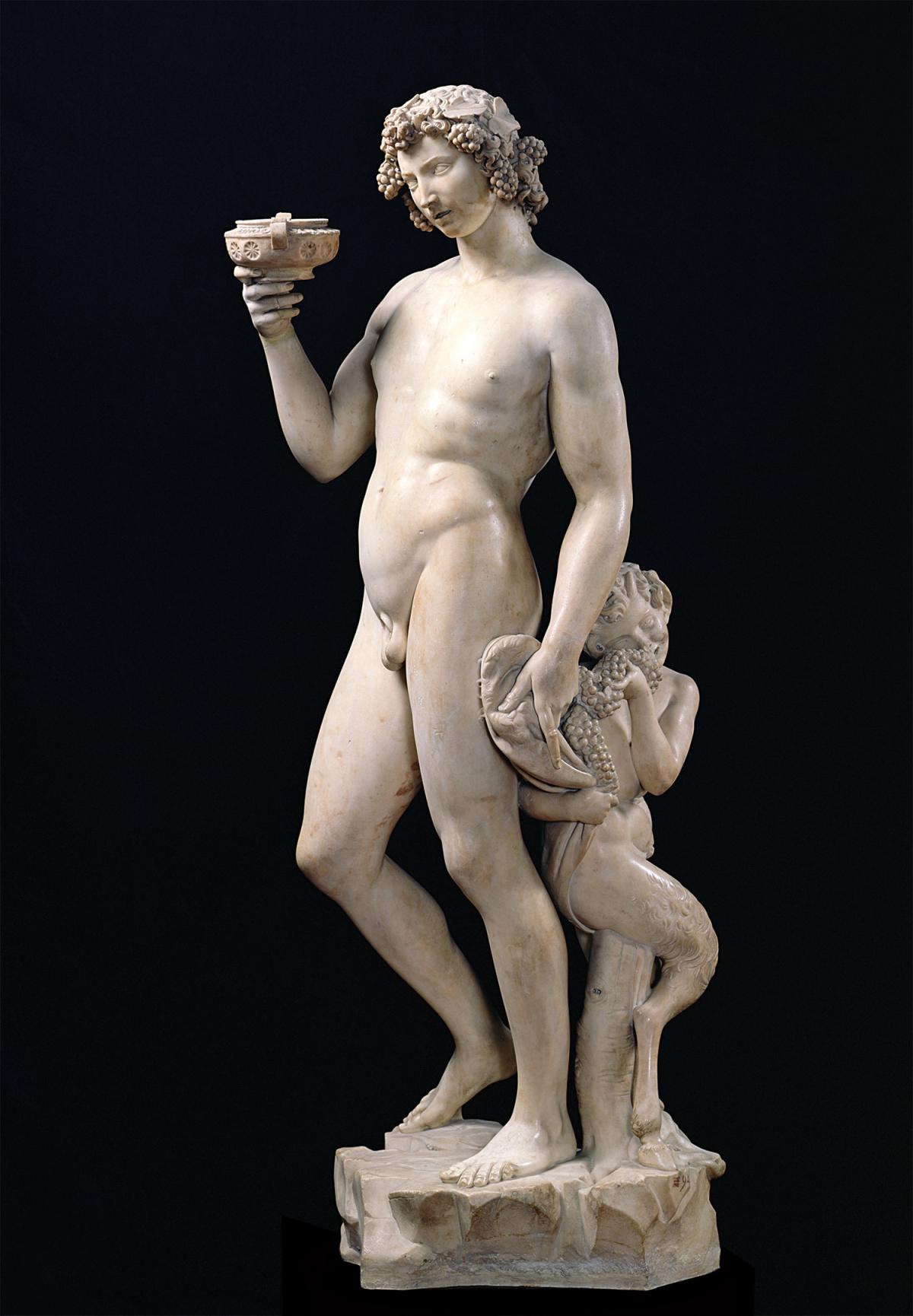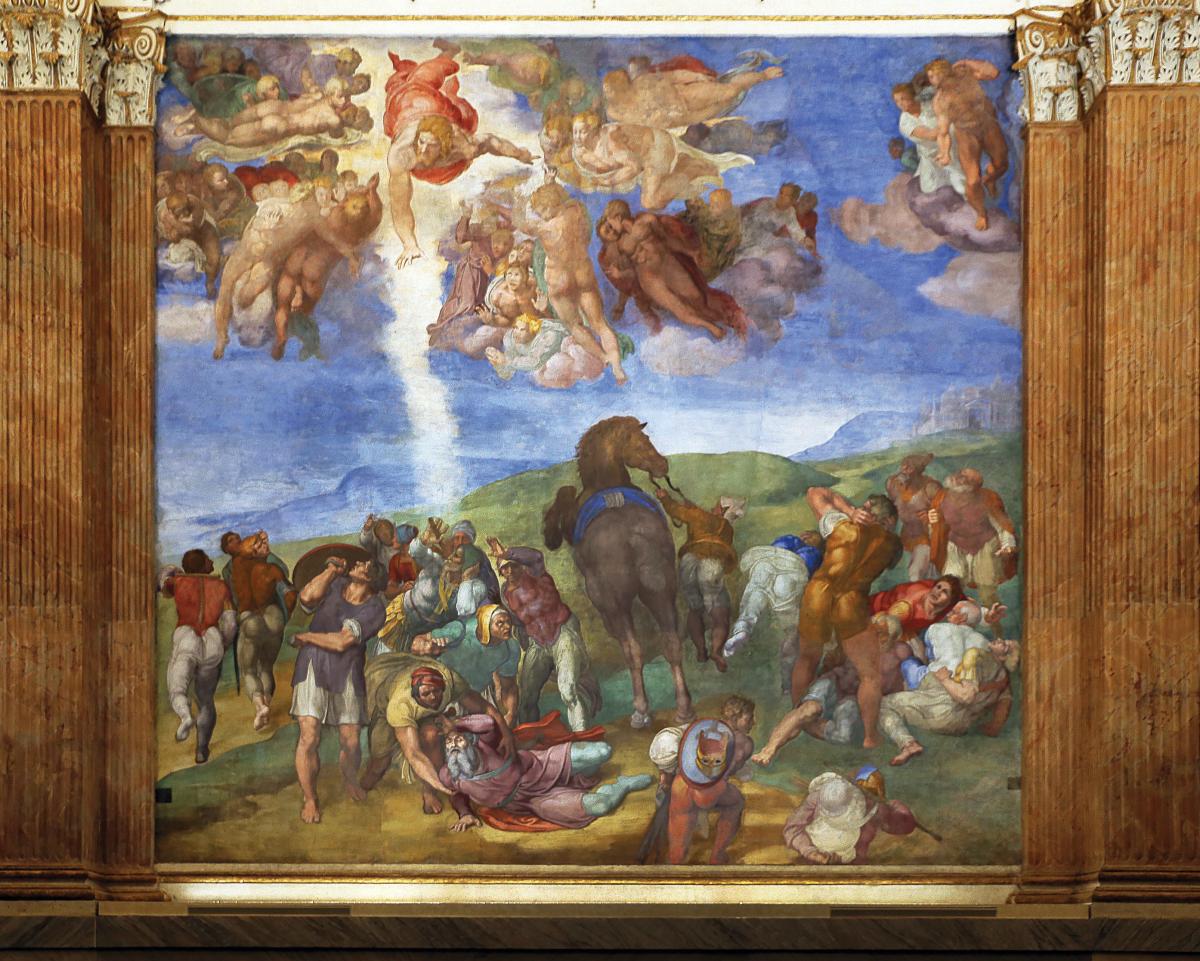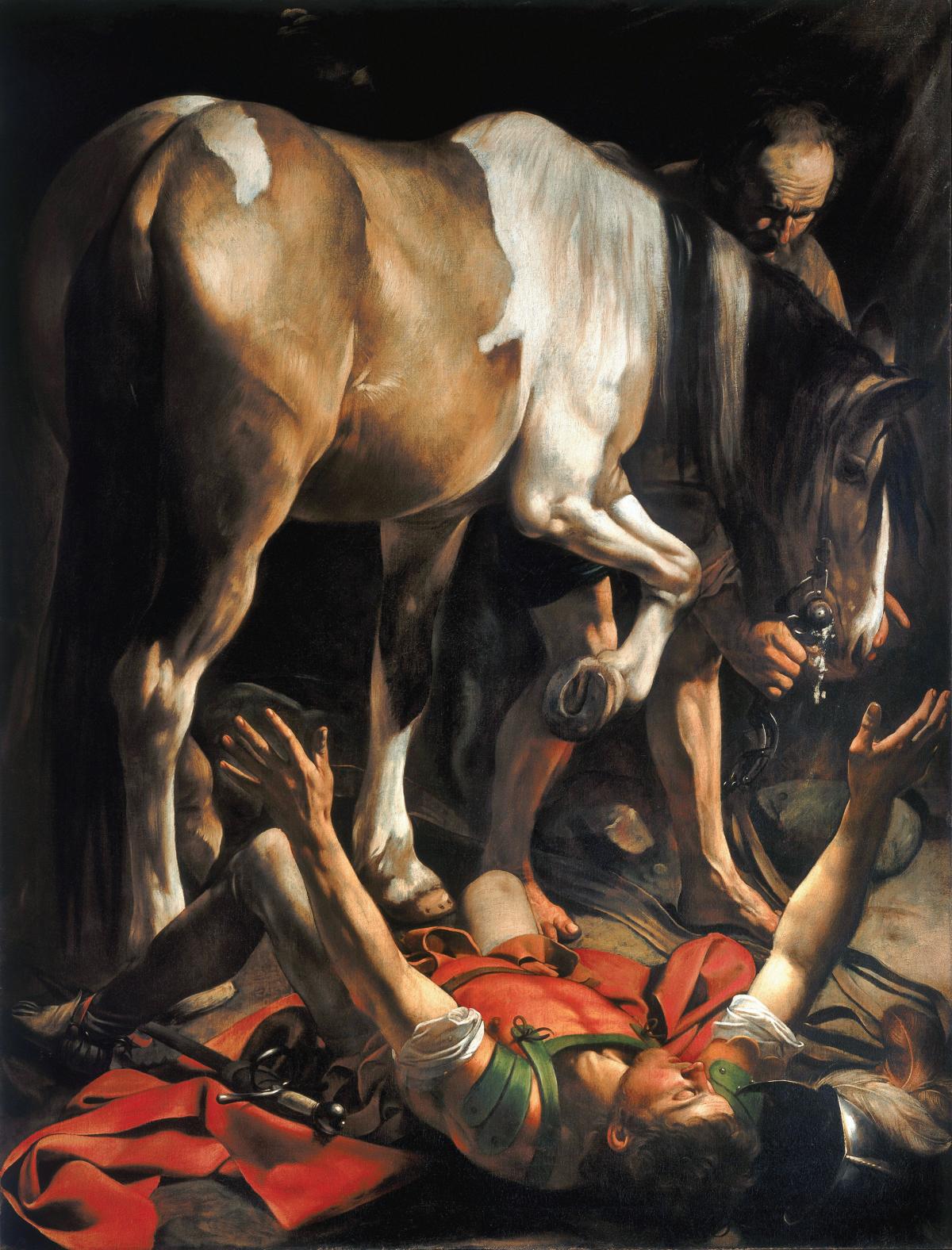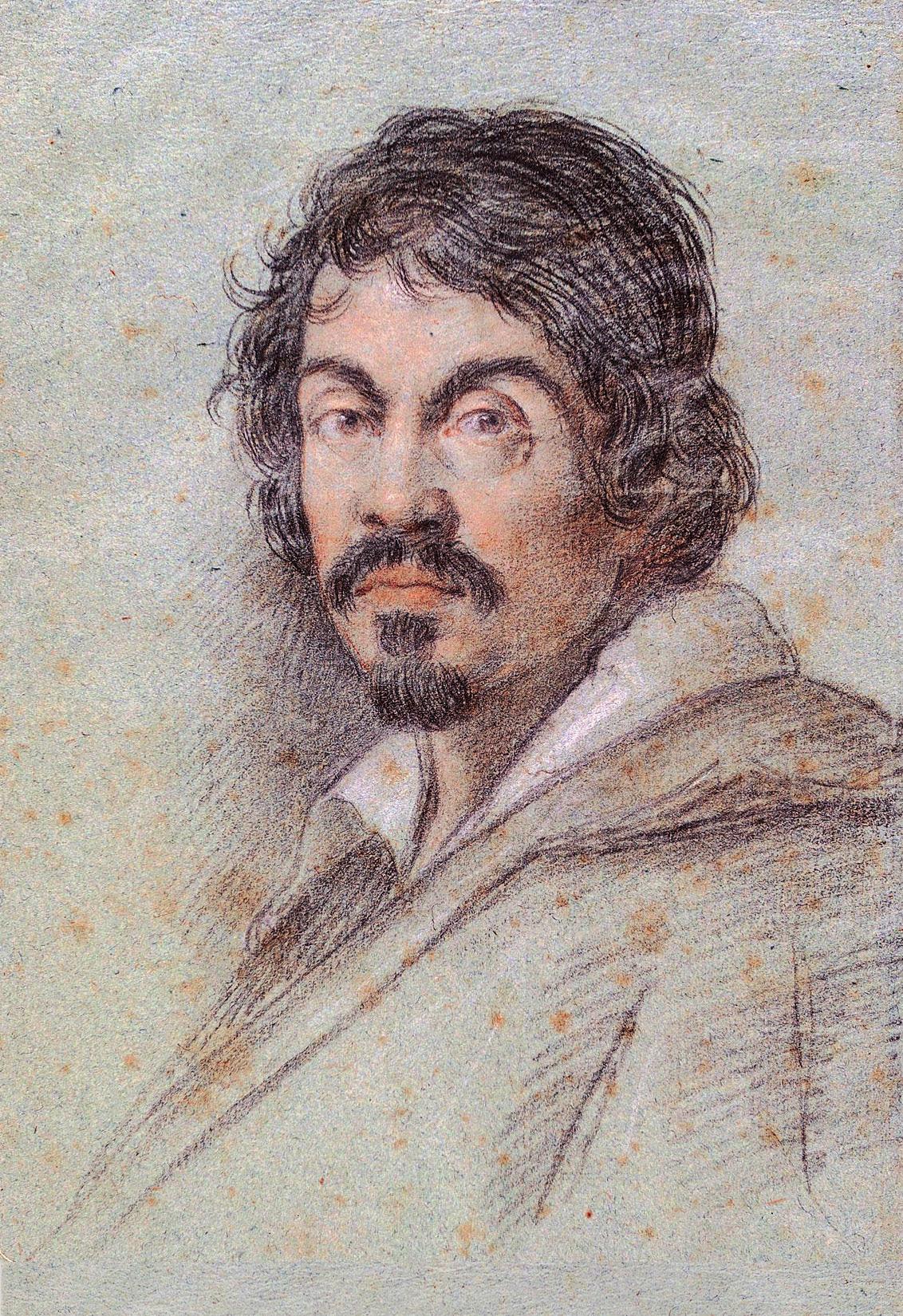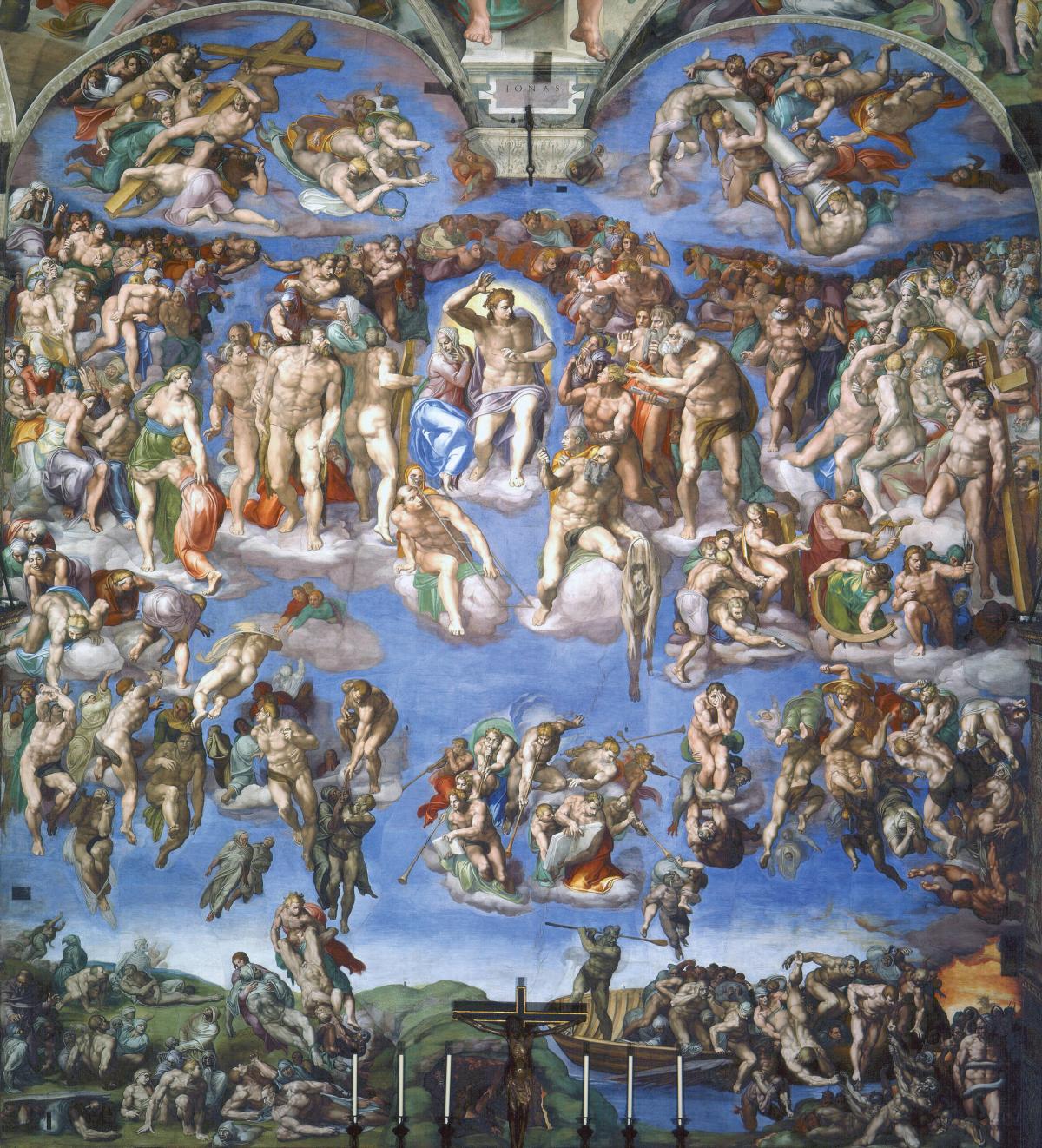Caravaggio’s Judith Beheading Holofernes is a gory picture. A young seductress slays the general sent to besiege her city, blood spraying from the wound in his neck. Michelangelo took up the same Biblical tale in the Sistine Chapel nearly a century earlier. In his fresco, nestled in one corner of the ceiling, Judith and her maid carry the tyrant’s head on a platter, their faces turned away. Michelangelo gave us a glimpse, Caravaggio, a front-row seat.
The haunting pitch of Caravaggio’s work inspired Peter Paul Rubens, Rembrandt, Jacques-Louis David, and Eugène Delacroix. Rembrandt’s The Return of the Prodigal Son, which hangs in the Hermitage Museum in St. Petersburg, is a spare canvas, warmed by the rich crimsons and ochres Caravaggio favored. It draws from the parable in Luke: A father embraces his wayward son, his older brother looking on bitterly—an apt allegory for Caravaggio, naturally impulsive, and Michelangelo, seemingly perfect but racked by self-doubt.
The two artists were not related and never met—Caravaggio was born seven years after Michelangelo died—but they shared a city and a name. Once Caravaggio, born Michelangelo Merisi, moved to Rome in 1592, he lived in the shadow of the Michelangelo—Michelangelo Buonarroti. Both were named after the archangel Michael, an angel among angels, who cast out the rebel spirits from Heaven. Michelangelo typified the archangel’s immaculate tendency, his lofty artistic ideals a model for all artists to follow. Caravaggio tended, instead, to the saint’s violent strain, his paintings charged and his life turbulent. The former was an archangel of artists, the latter a virtuosic painter, but no angel.
A meticulous student of the human form, Michelangelo rendered in marble the grace of motion. “He made his own research into human anatomy, dissected bodies, and drew from models,” E. H. Gombrich wrote in 1950, “till the human figure did not seem to hold any secrets for him.” Audiences marveled at his finely rendered Pietà. In the sobering sculpture, the Virgin Mary holds a lifeless Christ, eyes downcast, rich folds of fabric catching the light. His paintings were no less spellbinding. Writing about the artist’s frescoes in Italian Journey, Goethe remarked, “Until you have seen the Sistine Chapel, you have no adequate conception of what man is capable of accomplishing.”
Michelangelo’s legacy was inescapable in Rome. In addition to seeing the elder artist’s work, Caravaggio likely read Giorgio Vasari’s Lives of the Most Excellent Painters, Sculptors, and Architects, which likens Michelangelo to “a spirit with universal ability in every art and every profession, . . . being rather divine than human.” Michelangelo famously took issue with aspects of Vasari’s paean, hiring Ascanio Condivi to write an “authorized biography” that underlined the artist’s noble birth. “[Michelangelo] was an artist, but also a patrician,” the art historian William E. Wallace writes, “and he demanded to be treated as such.” Wallace notes that when Piero Soderini, the Standard Bearer of Justice in Florence, said that Michelangelo’s David had too thick a nose, the artist responded with an elegant sleight of hand:
Michelangelo climbed the scaffold, and grabbed his hammer and chisel and a handful of marble dust. He tapped lightly on the chisel, permitting dust to fall little by little from his hand, without actually altering anything. “Ah that’s much better,” exclaimed the duped observer. Michelangelo climbed down, “feeling sorry for those critics who talk nonsense in the hope of appearing well informed.”
The artist comes into view in Bette Talvacchia’s NEH-supported The Two Michelangelos, which examines how Michelangelo’s work is referenced in Caravaggio’s paintings and how Caravaggio, often in lurid detail, developed a style all his own.
Unlike Michelangelo, Caravaggio’s origins remain something of an enigma. Of the three early biographies of the artist, the first is brief; the second, written by one of Caravaggio’s rivals; the third, drawn mainly from the first two.
We know Caravaggio was born into a very honorable family in Milan and witnessed an outbreak of the bubonic plague in August 1576 that would claim the lives of his father and grandparents a year later—the grisliness of the disease a portent of the artist’s later work. He apprenticed in the workshop of Simone Peterzano, a student of Titian, and Cesari. Under the latter, Caravaggio was assigned a series of still lifes, the lowest-ranked subject matter of his day (trailing Biblical and mythological work, portraits, paintings of animals, and landscapes). When he left the workshop, it was on mysterious terms: The artist was kicked by a horse and not taken to the hospital or visited by anyone in the Cesari household. With the end of his apprenticeship, however, Caravaggio began work on the highest of commissions: religious paintings.
The Catholic Church that Caravaggio found in Rome was, critically, not Michelangelo’s. Where the elder artist was responding to esoteric Renaissance Christian Neoplatonism, which privileged idyllic beauty as a symbol of God-made man, Caravaggio was answering to the Counter-Reformation, with its emphasis on papal authority, worship of saints, and support for the poor. Drawing from the Franciscan tradition of Carlo Borromeo, who was named archbishop of Milan in 1565, Caravaggio turned his eye to the forgotten and the outcast. In his canvases, Andrew Graham-Dixon observes, “Christ and his followers looked a lot more like beggars than cardinals.”
The artist was drawing from experience. Dressed in black, Caravaggio spent his nights on the streets of Rome, sparring with naysayers. “[H]e gave himself up to the dark manner, and to the expression of his turbulent and contentious nature,” biographer Giovanni Pietro Bellori wrote. The figures in his paintings, themselves a kind of character study, are comparably desperate. Furrowed brows, strained muscles, disheveled hair: The men and women Caravaggio puts before us have nothing left to give and, having lost all else, ask only, Why not? The artist shared the streets with prostitutes, and may have been a pimp himself, enlisting the courtesan Fillide Melandroni to pose for a number of his canvases, her crooked finger left unaltered in his paintings.
Michelangelo was offended by the naturalism of early religious paintings, works of gritty physicality that Caravaggio would later bring to new heights. “Their painting is of stuffs, bricks and mortar,” Michelangelo said, “though it may appear good to some eyes, it is in truth done without reason, without symmetry or proportion, without care in selecting or rejecting.” Michelangelo was rooted in the Tuscan tradition, Talvacchia explains, aiming for the “best of nature” to attain an “idealized state of perfection.”
Caravaggio, by contrast, is associated with a Lombard style, which “insisted on the inclusion of flaws and infelicities found in life.” Far from deterring him, the ragged, the unvarnished, emboldened the artist. “[Caravaggio] wore only the finest materials and princely velvets,” Bellori remarked, “but once he put on a suit of clothes he changed only when it had fallen to rags.” As much a performer as any of his models, Caravaggio—the man—is revealed only in fragments, a neighbor we see across the way but never truly know. On a visit to a church in Sicily toward the end of his life, Caravaggio refused the holy water offered him. Told it was for venial sins, the artist replied, “Mine are all mortal.”
At first glance, Caravaggio’s Bacchus appears unassuming. In the darkly lit canvas, a young man, rosy cheeked and draped in a toga, holds a glass of wine, an array of fruits before him. As we look again, though, we can see the young Bacchus’s eyes are heavy with sleep, his fingernails dirty. There is more than a little field hand in this god. The fruit in the foreground is decaying, and his free hand rests on the dark bow at his waist. When Michelangelo sculpted the god of wine, he conjured up a lithe and well-proportioned youth, like many others by his hand, idyllic. But his Bacchus remains unknowable. Caravaggio’s is flawed, undoubtedly, but he is real. We can reach out and touch him. We can smell the wine on his breath.
“[Caravaggio] acknowledges the power of what he copies,” Talvacchia suggests, “but expresses it in a style so opposed to the values inherent in his model that the citation becomes derisive.” Caravaggio infused Michelangelo’s work—magnificent by any measure—with a deliberate potency. And the result smolders. “Caravaggio’s [imitation] is delivered in a quip rather than a quotation.”
To Michelangelo’s close study of anatomy, Caravaggio added a chilling realism. As the Sicilian biographer Francesco Susinno wrote, to complete The Resurrection of Lazarus, Caravaggio hired a set of workmen to hold a decaying corpse, many of the men unable to stand its foul odor. Susinno likened Caravaggio’s room to the slaughterhouse of Roman Emperor Maxentius, where “miserable creatures who were condemned . . . die tied to corpses.” While Lazarus could not, in fact, have been modeled off a rotting corpse, the story says much about the effect of Caravaggio’s paintings. His work, Talvacchia notes, aimed to “shatter the emotions.”
Naturalist that he was, Caravaggio was never just that. He was a dramatist, a scene-maker. In The Cardsharps, a man is swindled of his money in a gambling den, one cheat peeking over the man’s shoulder, another awaiting his winning hand. Suspended in our giddiness, we are party to the deception and, for a brief moment, revel in it alongside the cheats. “Contrary to contemporary opinion,” Angela Hass writes, “Caravaggio was anything but a mere imitator of nature, however alien his sophistication may have been to the conventions of his day.”
Michelangelo engaged in his own “sophisticated trickery,” Talvacchia suggests, his sculptures rivaling and, at times, passed off as works of antiquity. Cardinal Raffaele Riario purchased the artist’s Sleeping Cupid in 1496, thinking the sculpture a work of the ancients. When informed that it was completed, instead, by the then twenty-one-year-old Michelangelo, Riario was incensed and demanded his money back. Writing about the incident, Vasari sided with the gifted sculptor: “What greater vanity is there than that of those who concern themselves more with the name than the fact?”
In the preface to The Picture of Dorian Gray, Oscar Wilde wrote, “To reveal art and conceal the artist is art’s aim.” Perhaps Michelangelo and Caravaggio, their work abounding in conceits divine and dramatic, were after the same end: art that speaks in its own voice. Ever inventive, the two knew the rules and, critically, when to bend them.
In the autumn of 1600, Caravaggio was commissioned to paint The Conversion of St. Paul and The Crucifixion of St. Peter for the Cerasi Chapel—the same pair of works Michelangelo completed sixty years earlier for the nearby Pauline Chapel in the Vatican. Peter and Paul held a special place as patron saints of Rome, where it was believed the two were martyred on the same day. Michelangelo, in keeping with his monumental style, painted Paul’s conversion as an overflowing scene: a crowd breaks to reveal the blinded saint, a light from the heavens striking him down. Celestial figures and the men below shudder as they flee. Caravaggio, hampered by his predecessor’s frescoes, initially presented an equally frenzied work. It was promptly rejected. The twist of the knife was Annibale Carracci’s The Assumption of the Virgin, commissioned for the same chapel. Carracci, attempting to rattle Caravaggio, painted a work lavishly Baroque, the style that was eclipsing Caravaggio’s brand of naturalism.
The artist’s dilemma, then, was a fitting one: copying his namesake would not suffice, nor would a sweeping scene in the style of Carracci. Caravaggio returned to all that was left to him: the Scriptures. The story of Paul’s conversion in the Acts of the Apostles is gripping but simple: a single man, blinded, transformed, and saved. A more befitting scene one can hardly imagine for an artist like Caravaggio. The painter took Paul’s conversion and turned it inward, focused, doggedly, on the transformation of one man’s soul. In this, Caravaggio drew from the Imitatio Christi idea, advanced by the Church’s pauperist orders, which saw devotion to Christ as a true embodiment of his ideals. In the artist’s revision, Paul, arms outstretched like those of the savior, is brought to the fore. Shown on the ground, the saint is aglow with the light of salvation, a spiritual mystery at work within him.
Caravaggio, in need of redemption, soon found that his place in Rome was far from secure. By the early seventeenth century, the Catholic Church had shifted away from Borromean piety—a decidedly Caravaggesque style—toward a triumphalist posture, pronouncing that art should evoke the majesty of God. The artist, then in his early thirties, had earned a reputation as a volatile man. “After a fortnight’s work he will swagger about for a month or two with his sword at his side and with a servant following him,” Dutch artist Karel van Mander said. Caravaggio was “ever ready to engage in a fight or argument, with the result that it is impossible to get along with him.” He severed all ties with his family. When his mother’s estate was divvied up, Caravaggio took the money allotted him and left, never to meet his siblings again. When his brother, Giovan Battista, tried to visit him years later, Caravaggio “declared that he did not know him and that he was not his brother.” The artist moved with an uncertainty about his place in the world: an imposter posing as a nobleman.
In April of 1604, Caravaggio flew into a rage at a restaurant in Rome. The artist had asked his waiter which of the artichokes he ordered was cooked in oil, to which the server responded, “smell them and you will easily know.” A livid Caravaggio proceeded to throw his plate in the waiter’s face and grab his friend’s sword. The server escaped, but his slight was cutting: To know olive oil was to be a refined Roman, to not was to be a provincial Lombard. Akin to calling the artist a barone, “one who thinks he has taste but actually has none,” as Graham-Dixon puts it, the offhand remark stirred in the painter a righteous fury.
Caravaggio spent the last years of his short life—he died at thirty-eight—on the run. In May of 1606, the artist stabbed to death Ranuccio Tomassoni in what was originally declared a “tennis match” but was, in fact, a duel, then illegal in Rome. It is suspected that the painter taunted Tomassoni, calling his wife, Lavinia, unfaithful. Whatever the terms, Caravaggio was promptly charged with a capital sentence and exiled from Rome.
The artist first made his way to the Alban Hills, outside the city, where he painted David with the Head of Goliath for the chief administrator of papal justice, a mea culpa in oils. A far cry from Michelangelo’s sculpture of the boy hero, Caravaggio’s David, set against a chillingly black background and illuminated by a stark overhead light, looks with pity at the giant’s severed head, frozen in anguish. Goliath’s face, notably, was modeled off Caravaggio’s own: dark eyes, dark beard, seething.
To further ingratiate himself to the Church, Caravaggio set his sights on Malta. There, with the help of the well-connected Costanza Colonna—a marchioness who often bailed out the artist—Caravaggio joined the Knights of St. John. A brotherhood normally restricted to nobility or those of great merit, the knights allowed the artist into their fold under a set of stringent conditions, among them that he would not leave the island. In Malta, the artist completed The Beheading of St. John, an unnerving canvas in which the saint, pinned to the floor, is held by his hair, blood spilling onto the street in the foreground. The executioner reaches for his sword to deliver a last, lethal slash. Subtly calibrated, the blood pooling below the saint’s head reads “F. Michelangelo,” the “F” denoting “Fra” or “Brother,” as if to announce, in a suitably grim spirit, the artist’s new place in the religious order.
A month later, Caravaggio was embroiled in a new assault, this time with several of the island’s knights. The murky incident—conspicuously absent in the Maltese archives—landed the artist in jail the day before his Beheading of St. John was unveiled. Caravaggio escaped shortly thereafter to Naples, where he was brutally attacked on his way out of a tavern, seemingly for his earlier brawl in Malta. The ambush left the artist partially blind and crippled.
“His draughtsmanship, the way he draws with the brush, has collapsed altogether,” Graham-Dixon explains. His imprecise brushwork “shows us how the magic has evaporated.” In Porto Ercole on his way back to Rome, Caravaggio dies, perhaps of a heart attack, and, to prevent his body from decaying in the summer heat, is laid to rest in an unmarked grave.
Ottavio Leoni’s portrait of the artist, completed in 1621, is a spirited work of chalk on paper, revealing a man disquieted, his gaze fixed on something out of frame. His hair ever so slightly out of place, Caravaggio appears hurried, eager to get up and go somewhere just beyond reach.
The painter takes after Michelangelo here, who, talented as he was, comes across as preoccupied, unsettled even. Michelangelo was determined, obsessively so, to “raise up” his name, Wallace writes. In a letter to his younger brother, Giovansimone, who had been disrespecting his father, Michaelangelo wrote, “When I begin to raise [my family] up a little, you alone must be the one to confound and destroy in one hour what I have accomplished during so many years and with such pains.” Michelangelo worried that his other brother, Gismondo, was “making a peasant of himself,” a stain on the artist’s status.
Michelangelo’s exacting spirit, which brought his work to unrivaled heights, translated into a rigidity in his personal life. When asked to entertain a patron passing through Rome, according to Wallace, Michelangelo pronounced, “I am living here in a state of great anxiety and of the greatest physical fatigue: I have no friends of any sort and want none.” In the artist’s mesmerizing fresco The Last Judgment, Michelangelo lends his features to the flayed skin of Saint Bartholomew, “portray[ing] himself as a discardable bit of flesh,” Wallace writes, “tenuously held over hell, but in saintly hands.”
He was as hard-edged as Caravaggio was volatile. “The higher [Michelangelo] rose in the esteem of the world, the more bitter and difficult he became,” Gombrich wrote. “He was not only admired, but feared for his temper, and he spared neither high nor low.” The true character of an artist turns on his response to acclaim. For both men, moving through the world laid bare an enviable talent but also a pervasive fragility: one obscured by masterful work but there nonetheless.
Michelangelo for years exchanged letters with Vittoria Colonna, a relative of Caravaggio’s saving grace, Costanza Colonna. In his letters to Vittoria, Michelangelo was “strong as a giant” and “gentle as a child,” as German artist Paula Modersohn-Becker notes. When the noblewoman died in 1547, the artist wrote in a madrigal, “God, / from a world half aware, / took back her beauty, but left our eyes a blur.”
For Michelangelo, the only remedy for sorrow was keeping occupied. “[Y]ou will say that I am old and crazy,” the artist remarked, following Vittoria’s death, “I assure you that only distractions kee[p] one from going crazy with grief.” A student of Dante, Michelangelo also read the work of poet and scholar Giovanni Boccaccio, who, in opining about the role of the informed critic in Genealogy of the Gentile Gods, anticipates Michelangelo and Caravaggio:
You must read, you must persevere, you must sit up nights, you must inquire, and exert the utmost power of your mind. If one way does not lead to the desired meaning, take another; if obstacles arise, then still another; until, if your strength holds out, you will find that clear which at first looked dark. For we are forbidden by divine command to give that which is holy to dogs, or to cast pearls before swine.
Where the two artists diverge is not in their skill or in their sensitivity, both of which they had in abundance, but in their temperaments. Michelangelo was given over to anxiety, but his anger did not veer, as did Caravaggio’s, into the volatile. “Michelangelo approached his art as a struggle and was vanquished over and over again by its demands,” Talvacchia writes. “Yet he was so driven that the battles he set for himself in producing art resulted in a monumental corpus of excellence.” Michelangelo, ever the purist, left many a work unfinished but did not entangle himself in fiery brawls. Caravaggio, by contrast, had within him what Talvacchia calls a “wretchedly self-destructive force.” The painter could buy his freedom with a captivating canvas but not for long. When violence overcame Caravaggio, when his velvet clothes grew worn, there was no work of oils to hide behind, no painting to save him like the saints in his pictures. The artist was his own undoing.
On a visit to the Santa Maria di Gesù church in Sicily, Caravaggio was awed by a marble Madonna he found there. Remarking on the work, completed by Antonello Gagini, one of Michelangelo’s prized pupils, Caravaggio said, “Whoever wants her more beautiful, should go to heaven.” The painter challenged his namesake but not without a kind of reverence. Rivaling Michelangelo, Caravaggio achieved something richer than a mere copy: harrowing realism. His canvases are of people with dirty feet, unwashed hair, tattered clothes—the same sinners of the Gospel—beaten down but brilliantly realized. Dark as the scenes he staged are, the characters at the fore are aglow with light, as if lit from within. In the background of Caravaggio’s The Martyrdom of St. Matthew is a figure with the same ragged beard and penetrating gaze of the artist. He is fleeing the scene but turns back to see the horror before him, if only for a moment.


